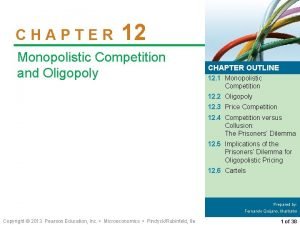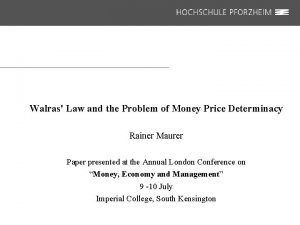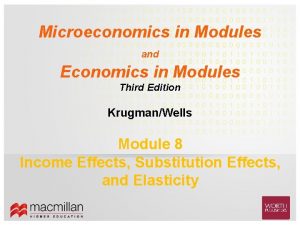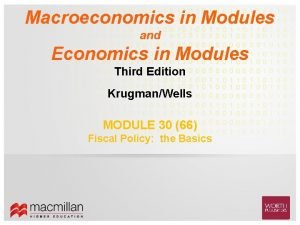Microeconomics in Modules and Economics in Modules Third



















- Slides: 19

Microeconomics in Modules and Economics in Modules Third Edition Krugman/Wells Module 6 Supply and Equilibrium

What You Will Learn 1 What the supply curve is 2 What affects supply 3 How the supply and demand curves determine a market’s equilibrium price and equilibrium quantity 4 In the case of a shortage or surplus, how price moves the market back to equilibrium 2 of 20

The Supply Schedule • A supply schedule shows how much of a good or service would be supplied at different prices. Supply Schedule for Cotton Price of cotton (per pound) Quantity of cotton supplied (billions of pounds) $2. 00 11. 6 1. 75 11. 50 11. 25 10. 7 1. 00 10. 0 0. 75 9. 1 0. 50 8. 0 3 of 20

The Supply Curve A supply curve shows graphically how much of a good or service people are willing to sell at any given price. Price of cotton (per pound) Supply curve, S $2. 00 1. 75 As price rises, the quantity supplied rises. 1. 50 1. 25 1. 00 0. 75 0. 50 0 7 9 11 13 15 17 Quantity of cotton (billions of pounds) 4 of 20

The Law of Supply • The law of supply says that other things being equal, the price and quantity supplied of a good are positively related. 5 of 20

An Increase in Supply • The improvement in cotton-growing technology generated an increase in supply —a rise in the quantity supplied at any given price. Supply Schedule for Cotton Price of cotton (per pound) $2. 00 Quantity of cotton supplied (billions of pounds) Before After improvement 11. 6 13. 9 1. 75 11. 5 13. 8 1. 50 11. 2 13. 4 1. 25 10. 7 12. 8 1. 00 10. 0 12. 0 0. 75 9. 1 10. 9 0. 50 8. 0 9. 6 6 of 20

An Increase in Supply • This event is represented by two supply schedules, one showing supply before the improvement, the other showing supply after the improvement. Supply Schedule for Cotton Price of cotton (per pound) $2. 00 Quantity of cotton supplied (billions of pounds) Before After improvement 11. 6 13. 9 1. 75 11. 5 13. 8 1. 50 11. 2 13. 4 1. 25 10. 7 12. 8 1. 00 10. 0 12. 0 0. 75 9. 1 10. 9 0. 50 8. 0 9. 6 7 of 20

An Increase in Supply Price of cotton beans (per pound) Improvement in the technology for growing cotton more cotton producers. S 1 $2. 00 S 2 1. 75 1. 50 1. 25 1. 00 0. 75 0. 50 0 7 9 11 13 15 17 Quantity of cotton (billions of pounds) A shift of the supply curve is a change in the quantity supplied of a good at any given price, or a change in supply. 8 of 20

Movement Along the Supply Curve Price of cotton (per pound) $2. 00 A movement along the supply curve… S 1 S 2 1. 75 1. 50 B 1. 25 A 1. 00 C … is not the same thing as a shift of the supply curve. 0. 75 0. 50 0 7 10 11. 2 12 15 17 Quantity of cotton (billions of pounds) A movement along the supply curve is a change in the quantity supplied of a good as a result of a change in that good’s price. 9 of 20

Shifts of the Supply Curve Price S 3 S 1 S 2 Increase in supply Any “increase decrease in in supply means leftward supply”ameans a shift of the supply rightward shiftcurve: of theat any given price, supply curve: at there any is agiven decrease the is an price, inthere quantity supplied. (S 1 increase in the quantity Ssupplied. (S 1 S 2) 3) Decrease in supply Quantity 10 of 20

Understanding Shifts of the Supply Curve • Changes in input prices – An input is a good that is used to produce another good. • • Changes in the prices of related goods and services Changes in technology Changes in expectations Changes in the number of producers 11 of 20

Individual Supply Curve and the Market Supply Curve The market supply curve is the horizontal sum of the individual supply curves of all firms in that market. 12 of 20

Economics in Action Only Creatures Small and Pampered • According to a 2007 article in the New York Times, the United States had a severe decline in the number of farm veterinarians over the past two decades. • The source of the problem is the higher demand for pet veterinarians. • Farm veterinary services and pet veterinary services are substitutes in production. 13 of 20

Supply, Demand, and Equilibrium • Equilibrium in a competitive market: The quantity demanded of a good equals the quantity supplied of that good. • The price at which this takes place is the equilibrium price (a. k. a. market-clearing price): – Every buyer finds a seller and vice versa. – The quantity of the good bought and sold at that price is the equilibrium quantity. 14 of 20

Finding the Equilibrium Price and Quantity Price of cotton (per pound) Market equilibrium occurs at point E, where the supply curve and the demand curve intersect. Supply $2. 00 1. 75 1. 50 1. 25 Equilibrium price E 1. 00 Equilibrium 0. 75 0. 50 0 Demand 7 10 Equilibrium quantity 13 15 17 Quantity of cotton (billions of pounds) 15 of 20

Price Above Its Equilibrium Level Produces a Surplus Price of cotton (per pound) There is a surplus of a good when the quantity supplied exceeds the quantity demanded. Surpluses occur when the price is above its equilibrium level. Supply $2. 00 Surplus 1. 75 1. 50 1. 25 E 1. 00 0. 75 0. 50 0 Demand 7 8. 1 Quantity demanded 10 11. 2 Quantity supplied 13 15 17 Quantity of cotton (billions of pounds) 16 of 20

Price Below Its Equilibrium Level Causes a Shortage Price of cotton (per pound) There is a shortage of a good when the quantity demanded exceeds the quantity supplied. Shortages occur when the price is below its equilibrium level. Supply $2. 00 1. 75 1. 50 1. 25 E 1. 00 0. 75 Shortage 0. 50 0 7 9. 1 10 Quantity supplied 11. 5 Demand 13 Quantity demanded 15 17 Quantity of cotton (billions of pounds) 17 of 20

Summary 1. The supply schedule shows the quantity supplied at each price and is represented graphically by a supply curve. Supply curves usually slope upward. 2. A movement along the supply curve occurs when price changes. 3. A change in the quantity supplied at any given price is a shifts of the supply curve. 4. Five main factors shift the supply curve: • A change in input prices • A change in the prices of related goods and services • A change in technology • A change in expectations • A change in the number of producers 18 of 20

Summary 5. The market supply curve for a good or service is the horizontal sum of the individual supply curves of all producers in the market. 6. The equilibrium price, or market-clearing price, is the price at which the quantity demanded is equal to the quantity supplied. 7. When quantity supplied is equal to quantity demanded, the market is at equilibrium quantity. 8. When the price is above its market-clearing level, there is a surplus that pushes the price down. 9. When the price is below its market-clearing level, there is a shortage that pushes the price up. 19 of 20
 Economics modules
Economics modules Gj mount classification of dental caries
Gj mount classification of dental caries Blacks classification
Blacks classification School of business and economics maastricht
School of business and economics maastricht Principle of economics third edition
Principle of economics third edition Pure public good
Pure public good Examples of microeconomics
Examples of microeconomics Definition of macroeconomics
Definition of macroeconomics Mathematical vs non mathematical economics
Mathematical vs non mathematical economics Copy
Copy What is the subject matter of microeconomics
What is the subject matter of microeconomics Limitations of macroeconomics
Limitations of macroeconomics Intermediate microeconomics lecture notes
Intermediate microeconomics lecture notes Intermediate microeconomics notes
Intermediate microeconomics notes Oligopoly model
Oligopoly model Walras law microeconomics
Walras law microeconomics Cowell microeconomics
Cowell microeconomics Microeconomics michael parkin 13th edition
Microeconomics michael parkin 13th edition Objective of microeconomics
Objective of microeconomics Almost essential
Almost essential



































